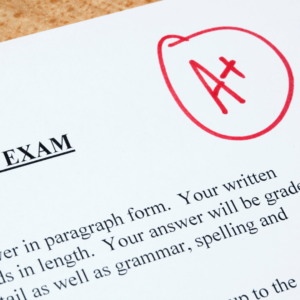Former teacher and Possip teammate, Savannah, shares best grading practices for teachers and school leaders.
It’s the end of the grading period, and suddenly piles of late work are being submitted, which consequently creates hours of grading and last-minute requests for extra credit. Students become anxious, teachers grow exhausted, and administrators feel uncertainty as deadlines quickly approach.
This is an experience students, teachers, and school leaders alike can relate to. While you may not have complete control over grading policies within your school or district, there are ways to alleviate some of this unnecessary stress that seems to repeat itself, ultimately leading to fatigue and burnout.
While grades and test scores may not always be an accurate measurement of student knowledge, they are nevertheless an important measurement of student progress and achievement. Grades ultimately help students identify areas where support is needed and their academic strengths. Additionally, grades can also create anxiety for students and teachers alike, especially when expectations aren’t clear ahead of time.
With this in mind, here is a list of best grading practices for both teachers and administrators.
For Teachers:
Align on the Why With Students:
As a teacher, I always encouraged my students to ask why. If they didn’t think the assignment was meaningful, or they didn’t know why they were tasked with it, we talked about it together. When students understand the purpose of the assignment and the learning objective(s) associated with it, they are more likely to put forth their best effort. In moments when you as the teacher or administrator feel uncertainty about the why, that’s an important opportunity to reflect on best practices.
It’s also an opportunity to be transparent with your students, which leads to student trust. When I taught AP, I would often tell students that it was my responsibility to prepare them for the test, which is why we sometimes needed to buckle down and work through multiple-choice questions. I would also explain to them how difficult tests were for me as a student, and how I wish I had more opportunities to practice, but also I could empathize with their apathy for multiple-choice. Sometimes, I would even share how as an educator, I felt split between preparing them for a test and preparing them to be critical thinkers and aware global citizens. This transparency created a culture of trust and respect that inherently influenced the way students showed up and participated.
Set Clear Expectations for Students:
Regardless of the grade level, spend time level-setting expectations for assignments
- Make sure directions are clear and concise.
- Ask a volunteer student to repeat the instructions in their own words.
- Take the time to ask any questions that need clarification.
- Revisit instructions if needed, especially if the assignment is complex or has multiple components.
- Share directions in a variety of ways for different learning styles.
Create a Visual and Digital Homework Board or Unit Calendar:
This may differ according to grade level but create a visual and digital homework/assignment board. At the beginning of the week, spend time reviewing the homework board and due dates. Encourage students to take a picture, use their calendars on their phones, or write down their assignments in an agenda. Additionally, if an assignment has multiple parts, model how you might break up an assignment and make smaller due dates for yourself based on your own needs and schedule. Time management and forward-thinking are important life skills that students often need support in developing. There are many apps for grading that can assist in these skills! Check them out here.
Create a Grade-Level Summative Assessment Calendar:
Students struggle to perform when they have multiple assignments due simultaneously. Create a grade-level Google calendar, or physical calendar, with summative assessments. If possible, try not to have more than one or two summative assessments due on the same day. Find summative assessment examples here!
Write Strong Assignment Titles and Descriptions:
Providing enough pivotal information so students can be successful and making sure not to write instructions that are too verbose is a difficult task. Create a method for naming assignments that’s clear and consistent. Share which category each assignment will be entered in, and how it will be weighted if necessary.
Provide Exemplars When Possible:
Exemplars can be difficult when you also want to encourage originality and creativity. However, exemplars and models truly do help students understand expectations.
Encourage Student Self-Assessment and Reflection:
Provide students with opportunities to assess and grade their work. Additionally, provide intentional opportunities for students to internalize feedback and reflect. For example, each student in my high-school English class had their own writing folder. When they received an essay or writing assignment back, they reviewed their grade and feedback. Then they created a writing goal for themselves. This goal had to be specific and aligned with the feedback. For example, “better grammar,” or “stronger vocabulary,” are not clear enough. However, “I will focus on sentence fluency by using a variety of sentence structures to improve my writing flow,” would be an acceptable goal. Students would then write this goal on top of their new assignment before submitting it. I would grade each assignment with that student’s specific goal in mind. Here are some extra ways to provide reflection and gratitude in the classroom!
For Administrators and School Leaders:
Encourage Consistency (school, grade level, subject):
As a school leader, it’s important to encourage consistency when it comes to grading policies. Decide if grading policies are decided on a whole school level, at the grade level, subject level, or individual classroom level.
Set Grade Book Expectations and Deadlines:
Set grade book expectations and deadlines and remind teachers in advance. Take time to review grade books with teachers and analyze student data. Here is a guideline to create grade books in excel!
Create Expectations for Regular Grade Book Checks:
Encourage teachers to review their grade books regularly, and take the time to look over grades with students. Help teachers support students and offer to be present during difficult conversations regarding grades. Identify struggling students early and offer interventions and support.
Encourage Collaboration Regarding Best Grading Practices:
Encourage collaboration within grade-level teams or subject areas regarding best grading practices. Teachers can take time to share model assignments, or bring upcoming assessments to review and receive feedback on.
Share Feedback Regularly with Teachers:
Create a regular cadence for sharing feedback regarding grade book checks and grading expectations with teachers. Ask teachers how they could feel more supportive and offer to help create strategies to ease teacher workloads when possible.
Grading can become overwhelming and stressful for all involved if it’s not done with intentionality and clear expectations. Use these best grading practices for yourself or with your colleagues to enhance your productivity within your school community!





